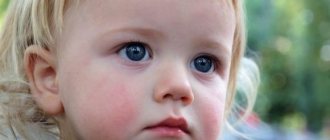Conjunctivitis is a fairly common disease that involves inflammation of the inner lining of the eyelids and sclera - the conjunctiva. In children, the disease manifests itself more often than in adults, since the disease often occurs against the background or as a consequence of previous diseases: measles, mumps, rubella, etc. Therefore, it is useful for parents to know how to treat conjunctivitis in children in order to urgently take action if it occurs first signs of illness.
There are conjunctivitis: viral, bacterial, allergic. The course of the disease in children and adults is practically no different. In order to make a correct diagnosis, a medical consultation with an ophthalmologist is required. Based on the results of the examination, a treatment regimen is developed.
Treatment of eye conjunctivitis in children
Before starting treatment for conjunctivitis in children, the cause of the inflammation should be established, this will guarantee a quick recovery, since similar symptoms may be present in other eye diseases: corneal ulceration, inflammation of the iris or glaucoma. To treat conjunctivitis for children, the ophthalmologist prescribes eye drops.
It is important to know that not all eye drops are suitable for a child, so you cannot do without consulting a doctor. Depending on the cause of the inflammation, bactericidal, antiviral, and antifungal drugs are used locally. Herbal treatment may be prescribed as an aid.
Basic rules for treatment
Before starting treatment for conjunctivitis, parents of children should know:
1. Medicines are always used on both eyes, even if only one is inflamed. Moreover, for prevention, drug treatment should always begin with a healthy eye.
2. Personal hygiene items should be kept away from family members.
3. It is forbidden to apply a blindfold. Without free access to air, the proliferation of pathogenic microorganisms increases significantly, which leads to the progression of the disease and its further spread to the cornea.
4. Before treating your eyes with medications (drops, ointments), you should first rinse them with disinfecting solutions. These can be medications or herbal infusions, such as furatsilin, chamomile decoction.
Regular tea brewing is considered an effective remedy, and one of the best is Chinese tea brewing (Folium Thea).
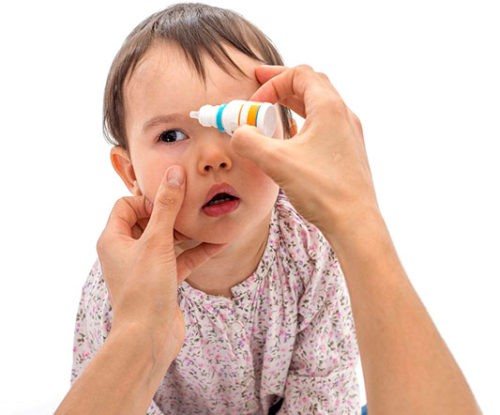
How to treat viral conjunctivitis in a child
The best medications for the treatment of viral conjunctivitis in children:
- “Oftan Idu.” Can be used from the age of two. The main active ingredient is idoxuridine solution plus excipients: boric acid and benzalkonium chloride. Strong antiviral agent. It disrupts the DNA of viruses and the possibility of the formation of new pathogenic cells. Cost 300/10 ml.
- "Ophthalmoferon" . Drops are often prescribed for the treatment of childhood viral conjunctivitis, but the instructions do not indicate at what age - use strictly as prescribed by the doctor. The main active substance is human interferon alpha 2 with a small content of dephenhydramine and boric acid.
A broad-spectrum drug: immunomodulator, suppresses the activity of pathogenic microbes, relieves inflammation. At the very beginning of treatment, frequent instillation is required up to eight times a day; as recovery progresses, the frequency gradually decreases. Cost 310 rubles per 10 ml.
- "Aktipol" . The instructions do not indicate at what age the medicine can be used - use as prescribed by a doctor. The active substance is aminobenzoic acid. The drops are quickly absorbed, have an immunomodulating, antiviral effect, and accelerate corneal regeneration. Cost 310/5 ml.
Treatment
The fight against conjunctivitis is based on determining the type of infectious pathogen and its elimination. Therapy can be prescribed even before the results of bacterial culture and microscopy are obtained. In uncomplicated cases, topical medications are used. Broad-spectrum antibiotics are prescribed as the main therapy for this purpose.
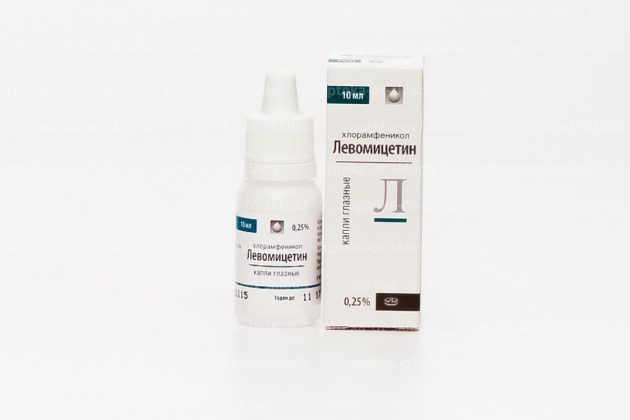
Eye drops to treat bacterial conjunctivitis :
- Levomycetin 0.25%.
- Erythromycin 1%.
- Ciprolet 0.3% (active ingredient – ciprofloxacin).
It is possible to use antibiotics in the form of ointments for placing behind the eyelids, and in complicated cases in a hospital setting - in the form of injections. To dissolve purulent crusts, diluted furatsilin and saline solution are used. To treat affected eyes, substances with antiseptic properties are widely used - Albucid, Miramistin.
How to treat bacterial conjunctivitis in a child? The same drugs, but only the doctor is involved in the selection of therapy (especially antibiotics): the concentration and dosage of all drugs must be previously calculated for the child’s body. So, Albucid will be used at a dilution of not 30, but 20%.
You should be especially careful when using traditional medicine. For example, using tea leaves as an eye wash in young children may increase the symptoms of conjunctivitis.
How to treat the bacterial form
Effective medications for the treatment of bacterial conjunctivitis in children:
- "Levomycetin" . Approved for use by children aged two years and older. Antibacterial antibiotic. Another inexpensive broad-spectrum medicine. A special feature is the use of drops twice a day, which is a definite plus - some drugs have to be used up to six times a day. Cost 18/5 ml.
- "Ciprofloxacin" . Can be used by children from one year of age. Antimicrobial bactericidal drug. It disrupts the DNA structure of bacteria and inhibits the proliferation of pathogenic microorganisms. Cost 17/5 ml.
- "Vitabakt" . Many young mothers do not know how to treat conjunctivitis in infants. "Vitabact" is an effective remedy that can be used in infants from the first month of life. The active substance is picloxidine. Antimicrobial drug. Cost 410/10 ml.
- "Albucid" (20% solution). Its other name is sulfacyl - sodium. One of the most popular means is its high efficiency and affordable price. Unfortunately, at the time of writing, it was out of stock in all major online pharmacies.
conclusions
At the age of 3, conjunctivitis can often be found in children (this is also an unpleasant disease for infants), so don’t be afraid, moms and dads, but think about how to treat this disease so that it does not develop into a chronic form. Constant inflammation of the conjunctiva in your child is a clear sign of a disorder of the immune system, so do not delay and contact a specialist. Do not let the disease take its course and do not try to treat it yourself. Run to the doctor immediately and follow all his recommendations. Familiarize yourself with the types and forms of this disease. Only in this case, conjunctivitis will not bring dangerous complications to the child and will quickly go away.
Read how to treat conjunctivitis in a child here.
How to treat an allergic form
The main condition for curing the allergic form of conjunctivitis in children is avoiding contact with the allergen.
- "Claritin." In the period from 2 to 3 years, it is allowed to use only in the form of syrup. Starting from 3 years of age, other forms of medication can be used in the form of tablets and drops. An antiallergic drug of the latest generation with a small list of side effects, the main one being drowsiness. Cost 270/60 ml.
- "Loratadine." Can be taken by children from the age of two. The antiallergic effect is noticeable after half an hour. Release form tablets 7; 10; 20 or 30 pieces per pack. Cost 10 pieces / 10 mg 66 rubles.
Treatment of conjunctivitis with herbs
Decoctions of medicinal herbs are used in the treatment of conjunctivitis in children as auxiliary means for washing the eyes before using drops or for treatment, in the form of lotions or compresses, which should be used for 15 minutes 3-4 times a day.
Herbal remedies are used to treat two types of diseases: bacterial and viral. Below is an effective medicinal collection of herbs that can be easily purchased at a pharmacy.
Medicinal collection:
- Blue cornflower flowers;
- Flowers (baskets) of chamomile;
- Eyebright herb.
Brew two tablespoons with a glass of boiling water. If treatment is slow, you can use preparations to boost immunity.
Treatment of pathology
The treatment regimen for conjunctivitis is selected by the doctor individually. The age of the child, the severity of the disease and its cause are taken into account. For any form of the disease, it is recommended to wipe your eyes with antiseptic solutions several times a day. To do this, you can use a strong decoction of chamomile or calendula, treat the child’s eyes with a solution of Furacilin, a weak solution of boric acid or Miramistin.
To treat each eye, take a separate cotton pad, which is moistened in a warm medicinal solution. Wipe the baby's eyes from the outer corner to the inner one.
Viral conjunctivitis
For viral conjunctivitis, treatment should be aimed at eliminating the root cause of the disease. For this purpose, antiviral drugs are prescribed, as well as drugs to strengthen the immune system. The patient may be prescribed Viferon, Groprinosin, Oxolinic ointment and interferon-based drugs.
In some cases, antibacterial drops are also prescribed at the same time. They help prevent secondary infection.
Bacterial conjunctivitis
The most common form of conjunctivitis diagnosed is bacterial. In this case, the patient is prescribed the following medications:
- Levomycetin drops;
- Phloxal;
- Albucid;
- Tobrex.
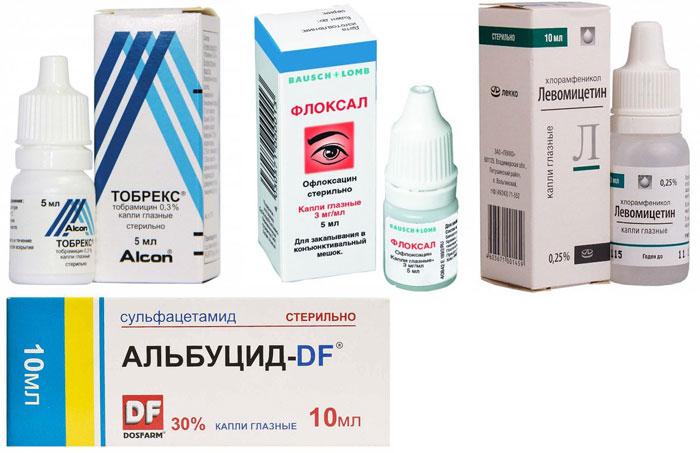
These drugs are instilled into the conjunctival sac 3-4 times a day for a week. Before treatment, the eyes must be thoroughly cleaned of purulent masses. After instillation, the organ of vision is covered and the eyeballs are actively moved for several seconds. This is necessary so that the medicine is well distributed.
Some kids don't like eye drops. In this case, the doctor prescribes eye ointments. Floxal and Tetracycline ointment are most often prescribed. These drugs are placed under the lower eyelid, in an amount of 1 cm. After this, close the eyes and gently massage the eyelids. Ointments have a viscous consistency, so they remain on the mucous membrane for a long time.
In severe cases of the disease, the sick child is prescribed systemic antibiotics. For conjunctivitis, preference is often given to drugs from the group of penicillins or macrolides.
Before starting to take any antibiotics, you should carefully read the instructions. If side effects occur, stop taking the medicine and consult a doctor.
Allergic eye inflammation
You need to start treating allergic conjunctivitis by eliminating any contact of the child with allergens. Quite often this is enough for the patient’s condition to improve. If the manifestations of allergies are strong, then antihistamines are prescribed - Tavegil, Cetrin, Loratadine or Claritin.
Antiallergic eye drops are often prescribed, which help quickly relieve swelling and inflammation. Can be written:
- Allergodil;
- Alomide;
- Opatanol;
- Lecrolin.
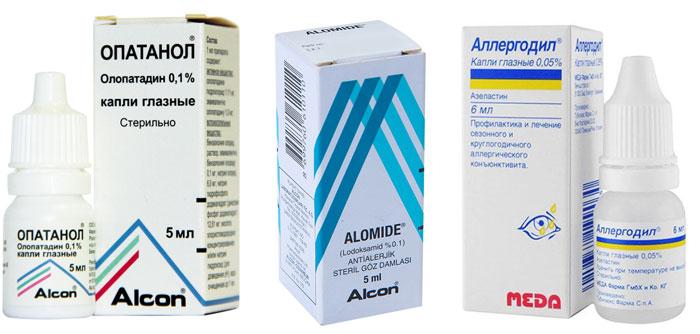
It is recommended to drop these drugs into the eyes 2 times a day. Only in severe cases, the frequency of use can be up to 4 times a day.
How does viral conjunctivitis differ from bacterial conjunctivitis?
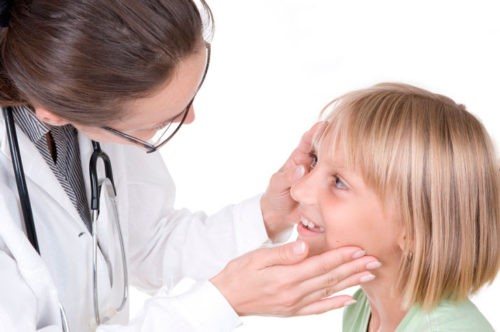
The difference is that with the viral form of the disease there is no purulent discharge. With the bacterial form, pus forms in the conjunctival sac, the contents are viscous, which causes the eyelashes to stick together. In any case, it is necessary to undergo tests, because treatment of conjunctivitis in children cannot be started without a correct diagnosis.
Symptoms of eye disease in children
Common symptoms of conjunctivitis in children requiring treatment include:
- Feeling of a foreign body under the eyelids;
- Burning, itching, tingling;
- Painful reaction to light;
- Excessive lacrimation (not always);
- The conjunctiva appears swollen, red, and bloodshot, and purulent or watery contents may be visible in the conjunctival sac.
1. Symptoms of viral conjunctivitis in children often appear simultaneously with diseases of the upper respiratory tract. Adenovirus infection is the most common causative agent of childhood eye disease. The incubation period after infection can be 4 - 10 days.
A peculiarity is the almost simultaneous damage to both eyes in a short period of time. Externally, the vessels of the eye noticeably enlarge, follicles appear on the conjunctiva, and there is a feeling of a foreign object being in the eye.
Severe itching, redness of the eyes, formation of tears, and fear of light appear. Film formation and serous discharge without pus may be observed. In rare cases, clouding of the cornea occurs, which is a particularly unfavorable symptom, often leading to a temporary decrease in vision for up to two years, even after the child has fully recovered. If you have the first similar symptoms in children, you should immediately contact an ophthalmologist and begin treatment for conjunctivitis.
2. Symptoms of the bacterial form often appear against the background of reduced immunity, often as a result of a recent infectious disease. The peculiarity is the short incubation period; if you do not start treating conjunctivitis in children in the very first hours, the disease will reach its peak in less than 2 days.
First, one eye is affected, then, usually after a short period of time, the other. Observed: severe swelling, burning and pain, sensation of the presence of a foreign body or sand, pus is abundantly released from the conjunctival sac, significant enlargement and redness of the eye vessels with slight hemorrhages are visible, follicles may form on the mucous tissue. Crusts form along the edge of the eyelid, often gluing the eyelashes together.
3. Symptoms of allergic conjunctivitis in children include simultaneous damage to both eyes. There is severe itching, swelling and redness of the eyes, fear of light, dry mucous membranes, and a feeling of sand. Vessels of bright red color are clearly visible. As the disease progresses, the eyes produce a thin, clear discharge, but may also produce a thick, thread-like mucous secretion.
Complications and consequences
Conjunctivitis in children 3 years old is not at all as harmless as it may seem - in the vast majority of cases, especially if the disease is of a bacterial or allergic nature, it is quite difficult to get rid of it without treatment. Moreover, the lack of proper therapy leads to a number of complications.
Typical consequences:
- Pathology of dry eyes. Long-term untreated conjunctivitis can cause “dry eye syndrome”, associated with insufficient production of fluids that moisturize the mucous membranes of the visual system;
- Blepharitis. A frequent complication of conjunctivitis, in which the eyelids succumb to secondary bacterial infection;
- Keratitis. A whole range of pathologies and disorders of the cornea - from deterioration of its transparency to the appearance of a cataract;
- Scarring of the soft tissues of the eye. With advanced forms of infectious eye lesions that penetrate deep into the organ, serious pathologies of the structures of the mucous membranes, retina and even vascular membranes can occur. Against this background, scarring of individual layers and entire localizations of the eye occurs, destructive and degenerative processes leading in the terminal stage to complete blindness;
- Other problems, syndromes, pathologies, diseases that negatively affect the child’s visual system.
Now you know everything about the treatment and symptoms of conjunctivitis in children aged 3 years.
Causes of conjunctivitis in a child
Common common causes include:
- Mechanical damage to the eye, exposure to ultraviolet, x-ray radiation, quartz lamp.
1. The viral form often signals the presence of a source of infection (viral, bacterial) in the child’s body. Often the disease occurs against the background of colds, as well as typical childhood diseases: measles, chickenpox, rubella. But, it manifests itself as an independent disease caused by the penetration of adenovirus, herpes simplex virus, and enterovirus into the body, which are the most common pathogens. Currently, about 150 varieties of viruses are known that can cause this type of conjunctivitis. Contagious. It is transmitted exclusively by airborne droplets.
2. Bacterial conjunctivitis in children is most often provoked by pathogenic microorganisms: streptococci, staphylococci, intestinal, hemophilus or pseudomonas aeruginosa, chlamydia, diphtheria bacteria and others. It occurs against the background of general hypothermia and eye injuries, decreased immunity, and diseases of the ENT organs. Contagious. It is transmitted by contact through the owner of eye secretions.
3. The allergic form is provoked by a certain allergen: pollen, smoke, high levels of chemical compounds in the air that cause irritation, baby shampoo or cream, pet hair.
Causes
Pathology occurs due to infection with gonococci, streptococci, chlamydia, staphylococci and other types of bacteria.

Damage to the mucous membrane and conjunctival sac (the space between the eyelids and the eyeball) occurs as a result of direct interaction with the pathogenic environment.
A high concentration of bacteria is observed in kindergartens and schools, especially if disinfectants are not used enough. In favorable conditions, active proliferation of bacteria begins, which causes an outbreak of the disease.
Factors provoking the disease:
- Congenital eye abnormalities (underdeveloped eyelids, lack of eyelashes). The baby is deprived of a natural barrier to the penetration of bacteria.
- Trauma to the mucous membrane of the eyeball.
- The air is too dry.
- Improper or irregular eye hygiene.
- The child rarely blinks. This usually happens when working on a computer and watching TV programs. Not enough tear fluid is produced, the membrane of the eye becomes vulnerable to external influences.
- Blockage of the tear duct. May be associated with congenital anomalies. It also occurs as a result of a foreign body entering the eye or the appearance of abscesses or tumors.
- Improper care of contact lenses and violation of the rules for their use (rarely washed, not removed at night, etc.).
- Decreased immunity. The body becomes vulnerable to infections, including those that cause CD.





